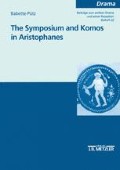Abstract
In Aristophanes’ ‘Acharnians’, ‘Peace’, and ‘Lysistrata’ the achievement of peace provides the possibility of feasting. ‘Acharnians’ was performed in 425 B.C. against the background of the Peloponnesian invasions of Attica, during which wide areas of land were devastated: cf. e.g. Thuc. 2.57.2, 3.26. The protagonist of this play, Dicaeopolis, is shown making a private peace for himself, in reaction to what he suffered and after becoming exasperated with the Athenian assembly. He then has to defend this action against those among the Acharnians who are in favour of war, as well as the war-monger Lamachus. In his function as the representative of peace, Dicaeopolis beats this Lamachus, the representative of war, in a competition between the life-styles of peace and war. To allow the audience to visualise how much more pleasurable Dicaeopolis’ life in peace is than that of his opponent during his war-expedition, the play employs symposium-imagery. Dicaeopolis celebrates both his victories, i.e. the achievement of peace and its successful defence, with komoi, each of which takes place as part of a festival, the Rural Dionysia and the Choes-day of the Anthesteria. The inclusion of these festivals in the play, together with the fact of the play’s own performance at a Dionysiac festival, the Lenaea,1 provides many further possibilities for allusions to feasting.
Preview
Unable to display preview. Download preview PDF.
Notes
Dodds, E. R., The Ancient Concept of Progress, Oxford 1973, 186 with n. 4;
Faraone, C.A., ‘Aristophanes, Amphiaraus, Fr. 29 (Kassel-Austin): Oracular Response or Erotic Incantation?’, CQ 42 (1992), 326 with n. 34; Sommerstein ad Pl. 382.
Habash, M., ‘Two Complementary Dionysiac Festivals in Aristophanes’ Acharnians’ AJP 116 (1995) 573 thinks that the girls are part of Dicaeopolis’ prize for his victory in the drinking-competition, but there is no evidence in the text for this hypothesis, especially since only the wineskin has been announced as the prize at 1002.
Rights and permissions
Copyright information
© 2003 Springer-Verlag GmbH Germany
About this chapter
Cite this chapter
Pütz, B. (2003). The symposium in Aristophanes. In: The Symposium and Komos in Aristophanes. J.B. Metzler, Stuttgart. https://doi.org/10.1007/978-3-476-02933-1_2
Download citation
DOI: https://doi.org/10.1007/978-3-476-02933-1_2
Publisher Name: J.B. Metzler, Stuttgart
Print ISBN: 978-3-476-45318-1
Online ISBN: 978-3-476-02933-1
eBook Packages: J.B. Metzler Humanities (German Language)

